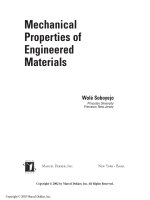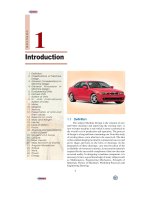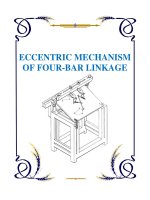Tài liệu Mechanical Properties of Engineered Materials P1 pptx
Bạn đang xem bản rút gọn của tài liệu. Xem và tải ngay bản đầy đủ của tài liệu tại đây (1.61 MB, 40 trang )
Marcel Dekker, Inc. New York
•
Basel
Mechanical
Properties of
Engineered
Materials
Wolé Soboyejo
Princeton University
Princeton, New Jersey
Copyright © 2002 by Marcel Dekker, Inc. All Rights Reserved.
Copyright © 2003 Marcel Dekker, Inc.
ISBN: 0-8247-8900-8
This book is printed on acid-free paper.
Headquarters
Marcel Dekker, Inc.
270 Madison Avenue, New York, NY 10016
tel: 212-696-9000; fax: 212-685-4540
Eastern Hemisphere Distribution
Marcel Dekker AG
Hutgasse 4, Postfach 812, CH-4001 Basel, Switzerland
tel: 41-61-260-6300; fax: 41-61-260-6333
World Wide Web
The publisher offers discounts on this book when ordered in bulk quantities. For
more information, write to Special Sales/Professional Marketing at the headquarters
address above.
Copyright # 2003 by Marcel Dekker, Inc. All Rights Reserved.
Neither this book nor any part may be reproduced or transmitted in any form or by
any means, electronic or mechanical, including photocopying, microfilming, and
recording, or by any information storage and retrieval system, without permission
in writing from the publisher.
Current printing (last digit):
10987654321
PRINTED IN THE UNITED STATES OF AMERICA
Copyright © 2003 Marcel Dekker, Inc.
Preface
My primary objective in this book is to provide a simple introduction to the
subject of mechanical properties of engineered materials for undergraduate
and graduate students. I have been encouraged in this task by my students
and many practicing engineers with a strong interest in the mechanical
properties of materials and I hope that this book will satisfy their needs. I
have endeavored to cover only the topics that I consider central to the
development of a basic understanding of the mechanical properties of mate-
rials. It is not intended to be a comprehensive review of all the different
aspects of mechanical properties; such a task would be beyond the capabil-
ities of any single author. Instead, this book emphasizes the fundamental
concepts that must be mastered by any undergraduate or graduate engineer
before he or she can effectively tackle basic industrial tasks that require an
understanding of mechanical properties. This book is intended to bridge the
gap between rigorous theory and engineering practice.
The book covers essential principles required to understand and inter-
pret the mechanical properties of different types of materials (i.e., metals,
ceramics, intermetallics, polymers, and their composites). Basic concepts are
discussed generically, except in cases where they apply only to specific types/
classes of materials. Following a brief introduction to materials science and
basic strength of materials, the fundamentals of elasticity and plasticity are
presented, prior to a discussion of strengthening mechanisms (including
composite strengthening concepts). A simple introduction to the subject
of fracture mechanics is then presented along with fracture and toughening
mechanisms and a description of the effects of fatigue and the environment.
Copyright © 2003 Marcel Dekker, Inc.
The book concludes with an overview of time-dependent viscoelastic/visco-
plastic behavior, creep, and creep crack growth phenomena. Wherever pos-
sible, the text is illustrated with worked examples and case studies that show
how to apply basic principles to the solution of engineering problems.
This book has been written primarily as a text for a senior under-
graduate course or first-level graduate course on mechanical properties of
materials. However, I hope that it will also be useful to practicing engineers,
researchers, and others who want to develop a working understanding of the
basic concepts that govern the mechanical properties of materials. To ensure
a wide audience, I have assumed only a basic knowledge of algebra and
calculus in the presentation of mathematical derivations. The reader is also
assumed to have a sophomore-level understanding of physics and chemistry.
Prior knowledge of basic materials science and strength of materials con-
cepts is not assumed, however. The better-prepared reader may, therefore,
skim through some of the elementary sections in which these concepts are
introduced.
Finally, I would like to acknowledge a number of people that have
supported me over the years. I am grateful to my parents, Alfred and
Anthonia, for the numerous sacrifices that they made to provide me with
a good education. I am indebted to my teachers, especially John Knott,
Anthony Smith, David Fenner, and Stan Earles, for stimulating my early
interest in materials and mechanics. I am also thankful to my colleagues in
the field of mechanical behavior who have shared their thoughts and ideas
with me over the years. In particular, I am grateful to Frank McClintock for
his critical review of the first five chapters, and his suggestions for the book
outline.
I also thank my colleagues in the mechanical behavior community for
helping me to develop my basic understanding of the subject over the past
15 years. I am particularly grateful to Anthony Evans, John Hutchinson,
Paul Paris, Robert Ritchie, Richard Hertzberg, Gerry Smith, Ali Argon,
Keith Miller, Rod Smith, David Parks, Lallit Anand, Shankar Sastry,
Alan Needleman, Charlie Whitsett, Richard Lederich, T. S. Srivatsan,
Pranesh Aswath, Zhigang Suo, David Srolovitz, Barrie Royce, Noriko
Katsube, Bob Wei, Campbell Laird, Bob Hayes, Rajiv Mishra, and many
others who have shared their understanding with me in numerous discus-
sions over the years.
I am indebted to my past and present staff scientists and postdoctoral
research associates (Chris Mercer, Seyed Allameh, Fan Ye, Pranav
Shrotriya, and Youlin Li) and personal assistants (Betty Adam, Alissa
Horstman, Jason Schymanski, Hedi Allameh, and Yingfang Ni) for their
assistance with the preparation of the text and figures. Betty Adam deserves
Copyright © 2003 Marcel Dekker, Inc.
special mention since she helped put the book together. I simply cannot
imagine how this project could have been completed without her help.
I am grateful to my students and colleagues at Princeton University,
MIT, and The Ohio State University who have provided me with a stimu-
lating working environment over the past few years. In particular, I thank
Lex Smits, my current department chair, and all my colleagues. My inter-
actions with colleagues and students have certainly been vital to the devel-
opment of my current understanding of the mechanical behavior of
materials.
Partial financial support for the preparation of this book was provided
by the National Science Foundation (DMR 0075135 and DMR 9458018). I
would like to thank the Program Managers, Dr. Bruce McDonald and Dr.
K. L. Murty, for providing the financial support and encouragement that
made this book possible. Appreciation is also extended to Prof. Tom Eager
and Prof. Nam Suh of MIT for inviting me to spend a sabbatical year as
Visiting Martin Luther King Professor in the departments of Materials
Science and Engineering and Mechanical Engineering at MIT. The sabba-
tical year (1997–1998) at MIT provided me with a stimulating environment
for the development of the first few chapters of this book.
I also thank Dawn Wechsler, Janet Sachs, Elizabeth Curione, and Rita
Lazzazzaro of Marcel Dekker, Inc., for their patience and understanding.
This project would certainly not have been completed (by me) without their
vision, patience, and encouragement.
Finally, I thank my wife, Morenike, for giving me the freedom and the
time to write this book. This was time that I should have spent with her and
our young family. However, as always, she was supportive of my work, and
I know that this book could have never been completed without her fore-
bearance and support.
Wole
´
Soboyejo
Copyright © 2003 Marcel Dekker, Inc.
Contents
Preface
1OverviewofCrystal/DefectStructureandMechanicalProperties
andBehavior
1.1Introduction
1.2AtomicStructure
1.3ChemicalBonds
1.4StructureofSolids
1.5StructuralLengthScales:Nanostructure,Microstructure,
andMacrostructure
1.6Summary
Bibliography
2DefectStructureandMechanicalProperties
2.1Introduction
2.2IndicialNotationforAtomicPlanesandDirections
2.3Defects
2.4ThermalVibrationsandMicrostructuralEvolution
2.5OverviewofMechanicalBehavior
2.6Summary
Copyright © 2003 Marcel Dekker, Inc.
Bibliography
3BasicDefinitionsofStressandStrain
3.1Introduction
3.2BasicDefinitionsofStress
3.3BasicDefinitionsofStrain
3.4Mohr’sCircleofStressandStrain
3.5ComputationofPrincipalStressesandPrincipalStrains
3.6HydrostaticandDeviatoricStressComponents
3.7StrainMeasurement
3.8MechanicalTesting
3.9Summary
Bibliography
4IntroductiontoElasticBehavior
4.1Introduction
4.2ReasonsforElasticBehavior
4.3IntroductiontoLinearElasticity
4.4TheoryofElasticity
4.5IntroductiontoTensorNotation
4.6GeneralizedFormofLinearElasticity
4.7StrainEnergyDensityFunction
4.8Summary
Bibliography
5IntroductiontoPlasticity
5.1Introduction
5.2PhysicalBasisforPlasticity
5.3Elastic–PlasticBehavior
5.4EmpiricalStress–StrainRelationships
5.5ConsidereCriterion
5.6YieldingUnderMultiaxialLoading
5.7IntroductiontoJ
2
DeformationTheory
5.8FlowandEvolutionaryEquations
(ConstitutiveEquationsofPlasticity)
5.9Summary
Copyright © 2003 Marcel Dekker, Inc.
Bibliography
6IntroductiontoDislocationMechanics
6.1Introduction
6.2TheoreticalShearStrengthofaCrystallineSolid
6.3TypesofDislocations
6.4MovementofDislocations
6.5ExperimentalObservationsofDislocations
6.6StressFieldsAroundDislocations
6.7StrainEnergies
6.8ForcesonDislocations
6.9ForcesBetweenDislocations
6.10ForcesBetweenDislocationsandFreeSurfaces
6.11Summary
Bibliography
7DislocationsandPlasticDeformation
7.1Introduction
7.2DislocationMotioninCrystals
7.3DislocationVelocity
7.4DislocationInteractions
7.5DislocationBowingDuetoLineTension
7.6DislocationMultiplication
7.7ContributionsfromDislocationDensityto
MacroscopicStrain
7.8CrystalStructureandDislocationMotion
7.9CriticalResolvedShearStressandSlipinSingle
Crystals
7.10SlipinPolycrystals
7.11GeometricallyNecessaryandStatisticallyStored
Dislocations
7.12DislocationPile-UpsandBauschingerEffect
7.13MechanicalInstabilitiesandAnomalous/Serrated
Yielding
7.14Summary
Bibliography
Copyright © 2003 Marcel Dekker, Inc.
8DislocationStrengtheningMechanisms
8.1Introduction
8.2DislocationInteractionswithObstacles
8.3SolidSolutionStrengthening
8.4DislocationStrengthening
8.5GrainBoundaryStrengthening
8.6PrecipitationStrengthening
8.7DispersionStrengthening
8.8OverallSuperposition
8.9Summary
Bibliography
9IntroductiontoComposites
9.1Introduction
9.2TypesofCompositeMaterials
9.3Rule-of-MixtureTheory
9.4DeformationBehaviorofUnidirectionalComposites
9.5MatrixversusCompositeFailureModesin
UnidirectionalComposites
9.6FailureofOff-AxisComposites
9.7EffectsofWhisker/FiberLengthonComposite
StrengthandModulus
9.8ConstituentandCompositeProperties
9.9StatisticalVariationsinCompositeStrength
9.10Summary
Bibliography
10FurtherTopicsinComposites
10.1Introduction
10.2UnidirectionalLaminates
10.3Off-AxisLaminates
10.4MultiplyLaminates
10.5CompositePlyDesign
10.6CompositeFailureCriteria
10.7ShearLagTheory
10.8TheRoleofInterfaces
10.9Summary
Copyright © 2003 Marcel Dekker, Inc.
Bibliography
11FundamentalsofFractureMechanics
11.1Introduction
11.2FundamentalsofFractureMechanics
11.3NotchConcentrationFactors
11.4GriffithFractureAnalysis
11.5EnergyReleaseRateandCompliance
11.6LinearElasticFractureMechanics
11.7Elastic–PlasticFractureMechanics
11.8FractureInitiationandResistance
11.9InterfacialFractureMechanics
11.10DynamicFractureMechanics
11.11Summary
Bibliography
12MechanismsofFracture
12.1Introduction
12.2FractographicAnalysis
12.3ToughnessandFractureProcessZones
12.4MechanismsofFractureinMetalsandTheirAlloys
12.5FractureofIntermetallics
12.6FractureofCeramics
12.7FractureofPolymers
12.8FractureofComposites
12.9QuantitativeFractography
12.10ThermalShockResponse
12.11Summary
Bibliography
13TougheningMechanisms
13.1Introduction
13.2TougheningandTensileStrength
13.3ReviewofCompositeMaterials
13.4TransformationToughening
13.5CrackBridging
Copyright © 2003 Marcel Dekker, Inc.
13.6Crack-TipBlunting
13.7CrackDeflection
13.8TwinToughening
13.9CrackTrapping
13.10MicrocrackShielding/Antishielding
13.11LinearSuperpositionConcept
13.12SynergisticTougheningConcept
13.13TougheningofPolymers
13.14SummaryandConcludingRemarks
Bibliography
14FatigueofMaterials
14.1Introduction
14.2MicromechanismsofFatigueCrackInitiation
14.3MicromechanismsofFatigueCrackPropagation
14.4ConventionalApproachtoFatigue
14.5DifferentialApproachtoFatigue
14.6FatigueCrackGrowthinDuctileSolids
14.7FatigueofPolymers
14.8FatigueofBrittleSolids
14.9CrackClosure
14.10ShortCrackProblem
14.11FatigueGrowthLawsandFatigueLifePrediction
14.12FatigueofComposites
14.13Summary
Bibliography
15IntroductiontoViscoelasticity,Creep,andCreepCrackGrowth
15.1Introduction
15.2CreepandViscoelasticityinPolymers
15.3MechanicalDumping
15.4TemperatureDependenceofTime-DependentFlow
inPolymers
15.5IntroductiontoCreepinMetallicandCeramic
Materials
15.6FunctionalFormsintheDifferentCreepRegimes
15.7SecondaryCreepDeformationandDiffusion
15.8MechanismsofCreepDeformation
Copyright © 2003 Marcel Dekker, Inc.
15.9CreepLifePrediction
15.10CreepDesignApproaches
15.11ThresholdStressEffects
15.12CreepinCompositeMaterials
15.13ThermostructuralMaterials
15.14IntroductiontoSuperplasticity
15.15IntroductiontoCreepDamageandTime-Dependent
FractureMechanics
15.16Summary
Bibliography
Copyright © 2003 Marcel Dekker, Inc.
1
Overview of Crystal/Defect Structure
and Mechanical Properties and
Behavior
1.1 INTRODUCTION
The mechanical behavior of materials describes the response of materials to
mechanical loads or deformation. The response can be understood in terms
of the basic effects of mechanical loads on defects or atomic motion. A
simple understanding of atomic and defect structure is, therefore, an essen-
tial prerequisite to the development of a fundamental understanding of the
mechanical behavior of materials. A brief introduction to the structure of
materials will be presented in this chapter. The treatment is intended to serve
as an introduction to those with a limited prior background in the principles
of materials science. The better prepared reader may, therefore, choose to
skim this chapter.
1.2 ATOMIC STRUCTURE
In ancient Greece, Democritus postulated that atoms are the building blocks
from which all materials are made. This was generally accepted by philoso-
phers and scientists (without proof) for centuries. However, although the
small size of the atoms was such that they could not be viewed directly with
the available instruments, Avogadro in the 16th century was able to deter-
mine that one mole of an element consists of 6:02 Â 10
23
atoms. The peri-
Copyright © 2003 Marcel Dekker, Inc.
odictableofelementswasalsodevelopedinthe19thcenturybeforethe
imagingofcrystalstructurewasmadepossibleafterthedevelopmentofx-
raytechniqueslaterthatcentury.Forthefirsttime,scientistswereableto
viewtheeffectsofatomsthathadbeenpostulatedbytheancients.
Aclearpictureofatomicstructuresoonemergedasanumberof
dedicatedscientistsstudiedtheatomicstructureofdifferenttypesofmateri-
als.First,itbecameapparentthat,inmanymaterials,theatomscanbe
groupedintounitcellsorbuildingblocksthataresomewhatakintothe
piecesinaLegoset.Thesebuildingblocksareoftencalledcrystals.
However,therearemanymaterialsinwhichnocleargroupingofatoms
intounitcellsorcrystalscanbeidentified.Atomsinsuchamorphousmate-
rialsareapparentlyrandomlydistributed,anditisdifficulttodiscernclear
groupsofatomsinsuchmaterials.Nevertheless,inamorphousandcrystal-
linematerials,mechanicalbehaviorcanonlybeunderstoodifweappreciate
thefactthattheatomswithinasolidareheldtogetherbyforcesthatare
oftenreferredtoaschemicalbonds.Thesewillbedescribedinthenext
section.
1.3CHEMICALBONDS
Twodistincttypesofchemicalbondsareknowntoexist.Strongbondsare
oftendescribedasprimarybonds,andweakerbondsaregenerallydescribed
assecondarybonds.However,bothtypesofbondsareimportant,andthey
oftenoccurtogetherinsolids.Itisparticularlyimportanttonotethatthe
weakersecondarybondsmaycontrolthemechanicalbehaviorofsome
materials,evenwhenmuchstrongerprimarybondsarepresent.Agood
exampleisthecaseofgraphite(carbon)whichconsistsofstrongprimary
bondsandweakersecondarybonds(Fig.1.1).Therelativelylowstrengthof
graphitecanbeattributedtothelowshearstressrequiredtoinducethe
slidingofstrongly(primary)bondedcarbonlayersovereachother.Such
slidingiseasybecausethebondsbetweenthesliding(primarybonded)
carbonplanesareweaksecondarybonds.
1.3.1PrimaryBonds
Primarybondsmaybeionic,covalent,ormetallicincharacter.Sincethese
arerelativelystrongbonds,primarybondsgenerallygiverisetostiffsolids.
Thedifferenttypesofprimarybondsaredescribedindetailbelow.
1.3.1.1IonicBonding
Ionic bonds occur as a result of strong electrostatic Coulomb attractive
forces between positively and negatively charged ions. The ions may be
Copyright © 2003 Marcel Dekker, Inc.
formed by the donation of electrons by a cation to an anion (Fig. 1.2). Note
that both ions achieve more stable electronic structures (complete outer
shells) by the donation or acceptance of electrons. The resulting attractive
force between the ions is given by:
F ¼À
Q
1
Q
2
r
2
ð1:1Þ
F
IGURE
1.1 Schematic of the layered structure of graphite. (Adapted from
Kingery et al., 1976. Reprinted with permission from John Wiley and Sons.)
F
IGURE
1.2 Schematic of an ionic bond—in this case between a sodium atom
and a chlorine atom to form sodium chloride. (Adapted from Ashby and
Jones, 1994. Reprinted with permission from Pergamon Press.)
Copyright © 2003 Marcel Dekker, Inc.
whereaisaproportionalityconstant,whichisequalto1=ð4"
0
),"
0
isthe
permitivityofthevacuum(8:5Â10
À12
F/m),Q
1
andQ
2
aretherespective
chargesofions1and2,andristheionicseparation,asshowninFig.1.2.
Typicalionicbondstrengthsarebetween40and200kcal/mol.Also,dueto
theirrelativelyhighbondstrengths,ionicallybondedmaterialshavehigh
meltingpointssinceagreaterlevelofthermalagitationisneededtoshear
theionsfromtheionicallybondedstructures.Theionicbondsarealso
nonsaturatingandnondirectional.Suchbondsarerelativelydifficultto
breakduringslipprocessesthataftercontrolplasticbehavior(irreversible
deformation).Ionicallybondedsolidsare,therefore,relativelybrittlesince
theycanonlyundergolimitedplasticity.Examplesofionicallybonded
solidsincludesodiumchlorideandotheralkalihalides,metaloxides,and
hydratedcarbonates.
1.3.1.2CovalentBonds
Anothertypeofprimarybondisthecovalentbond.Covalentbondsare
oftenfoundbetweenatomswithnearlycompleteoutershells.Theatoms
typicallyachieveamorestableelectronicstructure(lowerenergystate)by
sharingelectronsinoutershellstoformstructureswithcompletelyfilled
outershells[(Fig.1.3(a)].Theresultingbondstrengthsarebetween30and
300kcal/mol.Awiderrangeofbondstrengthsis,therefore,associatedwith
covalentbondingwhichmayresultinmolecular,linearorthree-dimensional
structures.
One-dimensionallinearcovalentbondsareformedbythesharingof
twoouterelectrons(onefromeachatom).Theseresultintheformationof
molecular structures such as Cl
2,
which is shown schematically in Figs 1.3b
and 1.3c. Long, linear, covalently bonded chains, may form between quad-
rivalentcarbonatoms,asinpolyethylene[Figs1.4(a)].Branchesmayalso
form by the attachment of other chains to the linear chain structures, as
shown in Fig. 1.4(b). Furthermore, three-dimensional covalent bonded
F
IGURE
1.3 The covalent bond in a molecule of chlorine (Cl
2
) gas: (a) planetary
model; (b) electron dot schematic; (c) ‘‘bond-line’’ schematic. (Adapted from
Shackleford, 1996. Reprinted with permission from Prentice-Hall.)
Copyright © 2003 Marcel Dekker, Inc.









